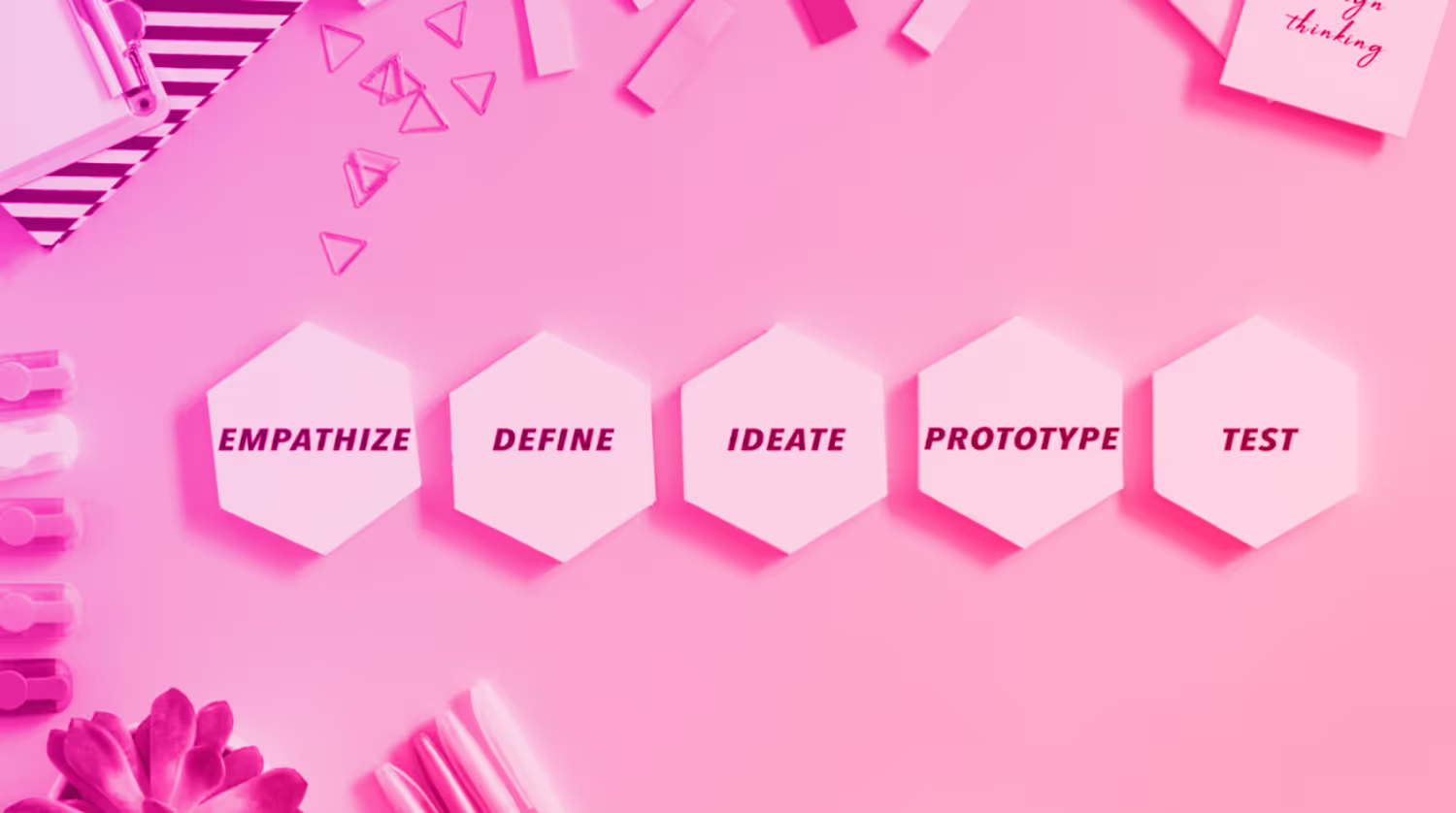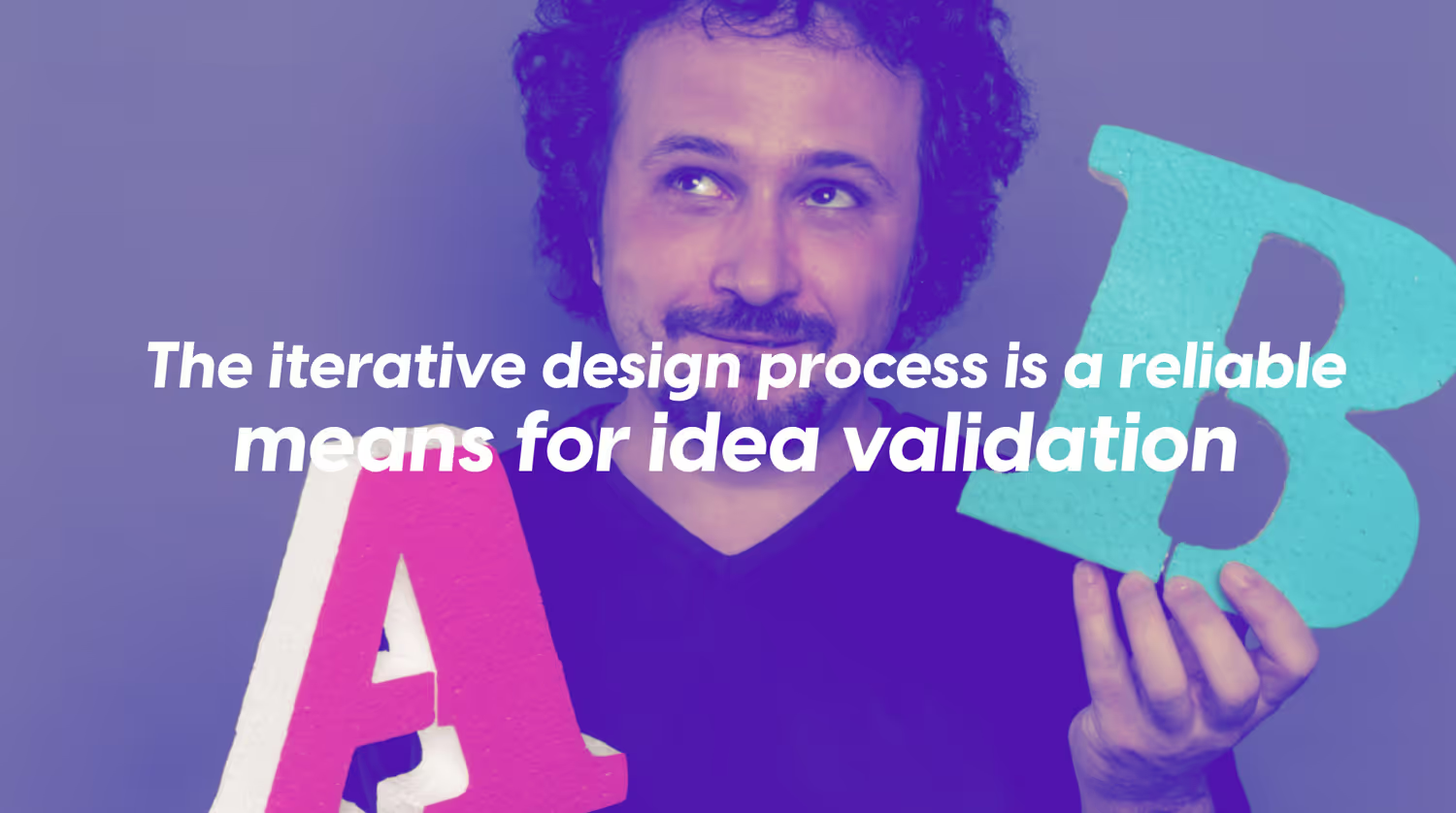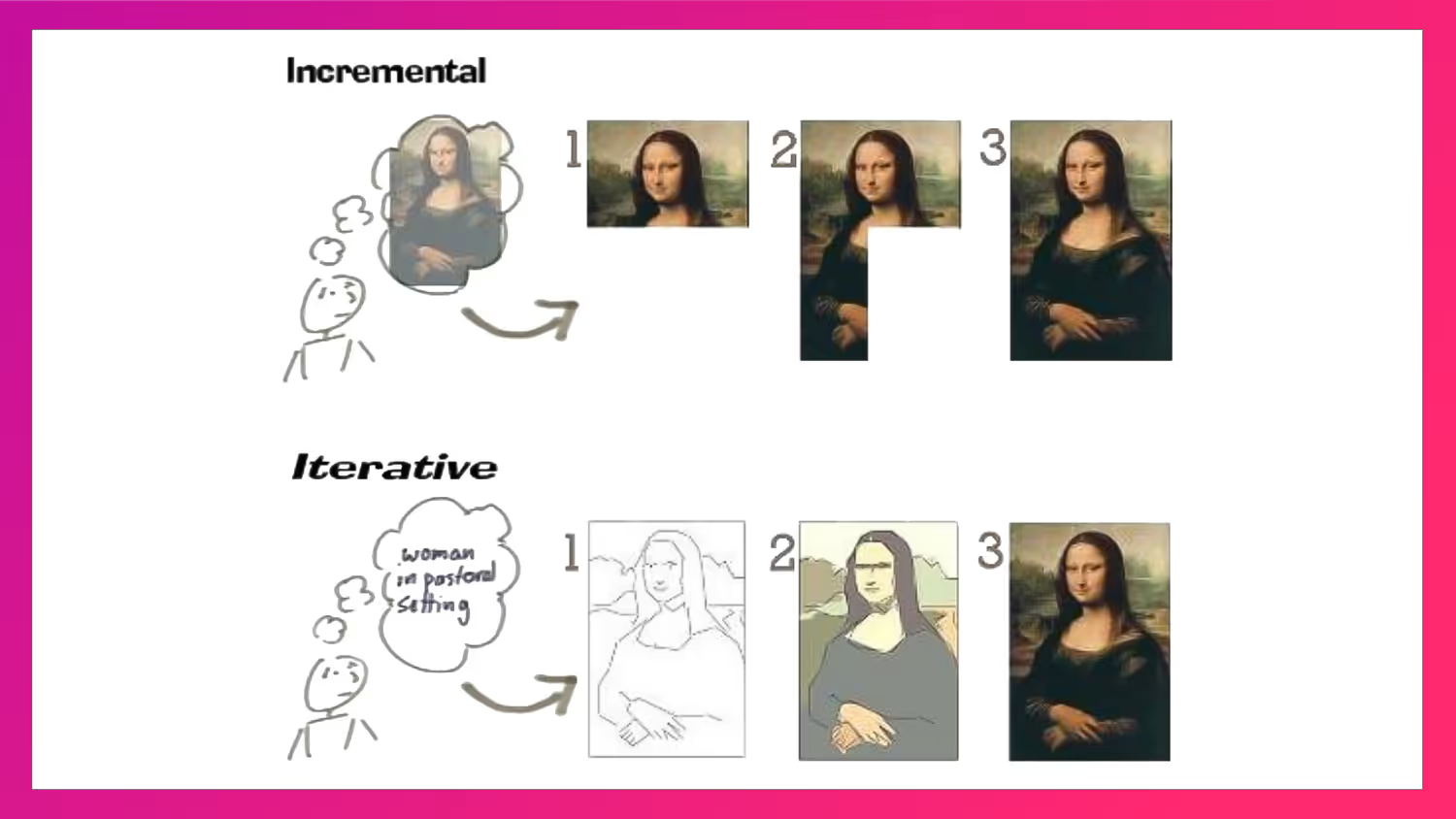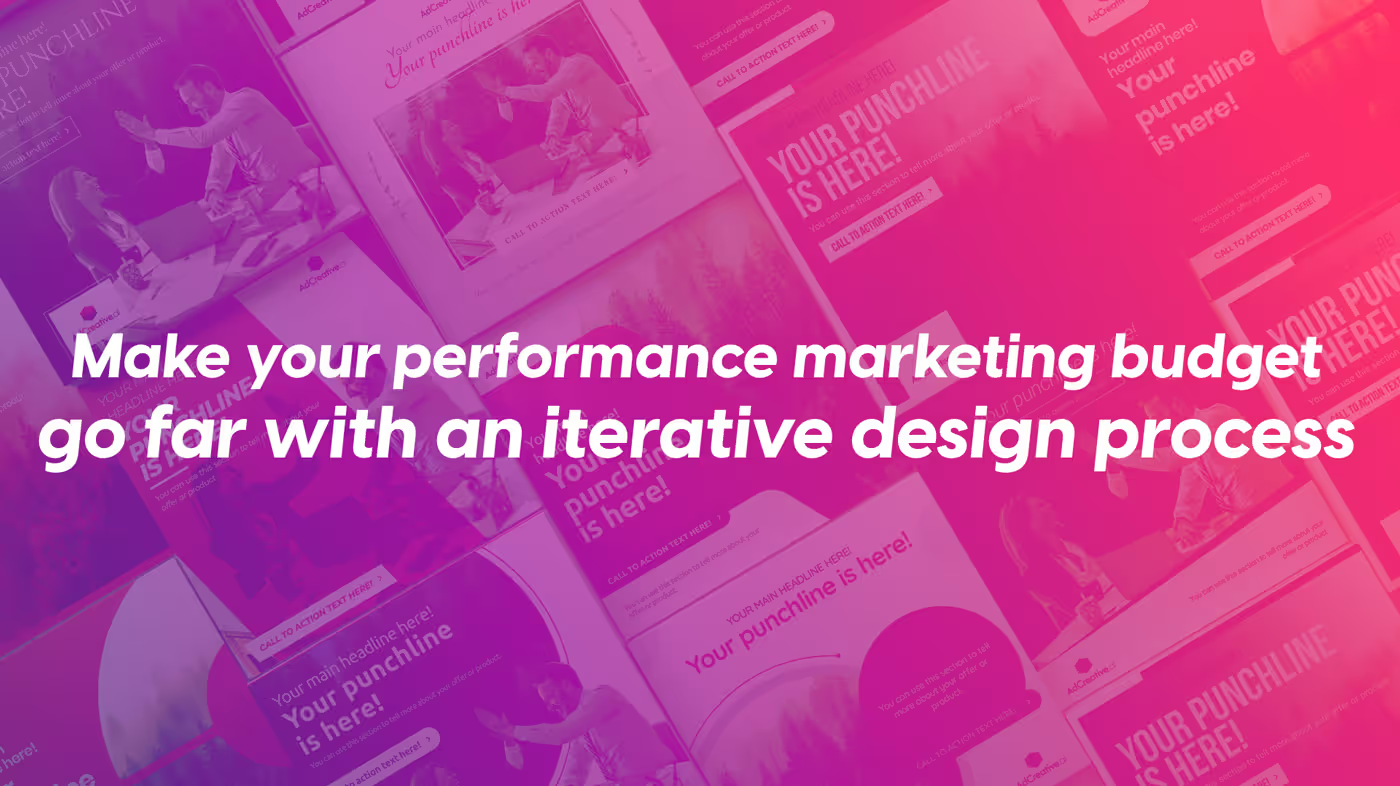Our world is built on the fundamentals of the iterative design process.
One could even argue that all development is largely a result of an iterative design process. Nature also seems to be fond of using an iterative design process in its workings.
Wondering how?
Think about the process of evolution in nature, and you’ll understand. We didn’t start the way we’re now, right? It has taken a long iterative design process for us and the world to be as we know it today.

We could even safely say that the iterative design process is not an indigenously developed concept by humans. We have merely observed it in the workings of the natural world and have developed our theories and experiments around our understanding of it.
In the modern world, technology has taken leaps and bounds on the back of iterative development. For a long time, we have considered creative development to be a very subjective and abstract process. However, it is no longer the case, or at least there isn’t as much grey area as there used to be.
We now have a greater understanding of how the creative process works, how it can be broken down into smaller steps, and how it can be defined with controlled parameters to have a predictable and quality outcome.
That is not to say that creativity is now a completely mechanical process with no room for unexpected sparks. On the contrary, we have understood certain aspects of creativity and how our brain functions that can be used in well-defined processes to free up our mental bandwidth to be truly creative and have a new stream of sparkling new ideas.
In this post, we’ll dive deeper into the realm of the iterative design process, particularly for marketers, and what some of the best-kept secrets about it are.
“Design is an iterative process. One idea often builds on another.” Mark Parker, Executive Chairman of Nike, Inc.
What is the “Iterative Design Process”?
The iterative design process is perhaps one of the best-kept secrets in the design world. It allows you to create better designs, faster and more efficiently.
But what is it, and how can you use it in your work?
An iterative design process is an approach to design that relies on repeated cycles of prototyping and testing.
This process allows you to test your ideas early and often, making it easier to find and fix errors.
It also helps you to use feedback from actual users, which can help you to create better designs. The iterative design process helps you unlock the power of design to solve complex problems.
There are a few things that make the iterative design process a powerful ally for you:
- Prototype often
One of the benefits of iterative design is that it allows you to prototype your ideas often. This means that you can make changes quickly and easily and see how your designs perform under different conditions.
- Be flexible
The iterative design process is flexible, which means that you can adapt it to meet your needs. You can change the order of the steps, or add or remove steps, depending on what works best for you.
- Test your prototypes
One of the most important steps in the iterative design process is the ability to test your prototypes, and you can do that faster, and quite often without having to worry much about the implications. This helps you course correct in time, and saves you from making colossal mistakes that either can’t be reversed or the damage is too great by the time you can take corrective actions.
Stages of the iterative design process

Planning, analysis, execution, testing, and assessment are all ongoing steps in the iterative design process. A design segment is produced by each cycle, and this segment serves as the foundation for the improvement cycle that follows.
Planning and establishing the broad criteria will be your first steps. Put your original design development effort into practice, then iterate through trial and error to make it better. This work period makes up the second part of the design project once the first cycle is over.
Ideally, the final design should get better with each cycle.
There is no set rate or formula for designing like this; rather, how quickly you progress through the iterative cycle depends on the design needs, skill levels of the design team, and resource availability.
The following are the typical stages of an iterative design process:
1. Planning and mapping requirements
Map out the initial requirements, gather the necessary documents or briefs, and create a plan and timeline for the first iterative cycle at this stage.
2. Analysis and design
Based on the plan, finalize the business or campaign requirements, design models, and technical specifications required by various platforms.
Create a working design, sketch, mood board, mockup, etc. that meets your required specifications.
Get feedback from internal teams to make sure your initial design plan is aligned with business requirements.
3. Execution and go-live
Create the functionality and design necessary to satisfy the requirements. Make the required variations and go live.
4. Testing and optimization
Determine and pinpoint what isn't functioning or performing as expected. At this stage, users, testers, and stakeholders offer their opinions and personal experiences.
Continually optimize your designs and keep improving with this live feedback loop.
5. Evaluation, review, and refinement
Compare the requirements and expectations with this iteration. Evaluate if you’ve found the desired outcomes. Refine your designs based on the gaps found during this review before moving on either with the next iteration cycle or towards solving the next problem.
It's time to take on the next cycle once you've finished these stages. The design goes back to step one in the iterative process to build on what is successful. Document the lessons you took away from the last iteration, and share them with the team.
The iterative design process, also known as circular or evolutionary design, is the process of improving the first version through successive iterations, especially as requirements are gathered and added. It enables you to maintain your flexibility as you discover new requirements or unforeseen challenges.
Why should marketers use an iterative design process?

As a marketer, you are always looking for ways to improve your campaigns and get better results. One way you can do this is by using an iterative design process.
As we defined earlier in this post, an iterative design process is a type of design that allows you to make small changes to your campaigns over time. This means that you can test different elements of your campaigns and see which ones are the most effective.
By using an iterative design process, you can constantly improve your campaigns and get better results.
There are a few reasons why you should use an iterative design process to create better-performing marketing strategies and campaigns:
- You can constantly improve your campaigns
- You can test different elements of your campaigns
- You can get better results
- You can save time and money
- You can be more flexible
If you are looking for ways to improve your campaigns, then you should definitely consider using an iterative design process. It can help you to make small changes that can have a big impact on your results.
5 best kept secrets about the iterative design process
“Great design is an iteration of good design.” Onur Mustak Cobanli, founder of OMC² Design Studios and Jury Coordinator of international design awards
Having understood all the basics of an iterative design process, now we want to talk about what our headline promised you: some of the best-kept secrets about the iterative design process.
1. Start with an end in your sight

“Begin with the end in mind” is the second habit in the bestselling book “The Seven Habits of Highly Effective People” by the legendary Dr. Stephen R. Covey.
This habit is based on the principle that all things are created twice: once in your mind and once in the physical world.
Having a clear vision of the end outcome and starting your design process with that clarity can make a world of difference when it comes to developing a successful design solution to any complex problem.
Having said that, don’t confuse it with starting with a clearly defined result. You need to have a clear line of sight of what you want to achieve broadly. The result could be way better than what was thought possible when you started.
Marketers and designers often get caught up in the intermediary stages of the execution process, and it’s easy to lose the endpoint of the whole effort.
The iterative design process is what makes achieving that lofty vision with which the design team might have started. Not only that, the iterative design process makes it manageable by breaking it down into easy steps and quick iterations. That makes it less overwhelming for designers.
The iterative design process also makes it less abstract by giving clarity at each step. And all of this makes for an effective, reliable, and repeatable process instead of a fluke.
So start with an end goal in sight and use the iterative design process to reach that end goal.
a. The iterative design process is a reliable means for idea validation
The iterative design process is a reliable way to validate your ideas. By constantly tweaking and improving your designs based on user feedback, you can ensure that your final output is the best it can be.
This process is especially important in the world of marketing, where a smart iterative design strategy can make all the difference.
By constantly testing and iterating on your marketing efforts, you can ensure that you're reaching your target audience and making the biggest impact.
A/B testing is a popular method used by marketers to test out and validate their ideas in order to find a winning one. It is a form of the iterative design process where you test two similar ideas with a key difference and see which one outperforms the other. Then you take the winner and repeat the same process until you’ve found either a clear winner or an optimal one.

By doing it in this methodical way, you’re taking the guesswork out and finding the winners based on the user feedback.
2. Iterative is not equal to incremental

Iterative design should not be mistaken for an incremental design process. Both are not the same and should not be used interchangeably. That would mean a gap in the fundamental understanding of both of these important concepts.
The above image is a famous example that is often used to explain the differences between iterative and incremental design processes. In his paper "Are Agile Methods Good for Design?", John Armitage is credited with being the first to introduce and explain this concept. And Jeff Patton is credited with this illustration to demonstrate how incremental development works in theory vis-a-vis iterative.
Let’s take another simple example from real life to help understand the difference between incremental and iterative design processes.
Designing a blueprint for a house construction project would benefit from an iterative design process. The builder, various contractors, the architecture, and the owners of the house would go through multiple iterations before reaching the detailed blueprint design that is finalized.
Actual construction will be done based on this final blueprint of house design. It’ll be an incremental process as everyone involved in the process already knows what the end outcome is. This would be divided into various stages of construction.
Gradually and carefully, each planned stage will be completed fully before moving on to the next stage. There is no scope for iteration here. Redoing any part of the construction process would come with heavy costs and delays. And that’s why all of the iterations were undertaken while finalizing the blueprint.
Another simple example to understand this would be the film production process. Pre-production planning is an iterative design process. Actual shooting and production go on the floor only after that, and a film is shot incrementally to cover all aspects of the screenplay. Iterations during the production and post-production blueprint stages would have heavy cost implications.
3. The iterative design process is a smart marketing strategy
As businesses strive to stay ahead of the competition, they are increasingly turning to iterative design processes to create smarter marketing strategies. By using data and feedback from customers, businesses can continuously improve their products and services to better meet the needs of their target market.
While traditional marketing efforts focus on a one-time campaign or product launch, iterative design takes a long-term view, constantly tweaking and improving the user experience. This approach has been proven to be successful time and time again, as it allows businesses to quickly adapt to changing market conditions and customer needs.
With the help of Artificial Intelligence, businesses can automate many of the tasks involved in an iterative design process, making it even more efficient and effective. By using AI to gather data and feedback, businesses can save time and resources while still delivering a superior product or service.
Adcreative.ai can give your marketing campaigns an unfair advantage with high-performing creatives such as ad banners generated by our highly trained Artificial Intelligence.
If you're looking to create a smarter marketing strategy, consider using an iterative design process. With the help of AI, you can continue to improve your offerings and better meet the needs of your customers.
4. Make your performance marketing budget go far with an iterative design process
Performance marketers are always looking for ways to get the most out of their campaign budget. One way to do this is to use an iterative design process to improve your marketing strategy.
An iterative design process in performance marketing incorporates user feedback and continual refinement during a campaign. By constantly testing and tweaking your approach, you can improve your marketing ROI and make your budget go further.
Of course, this takes some time and effort. But the rewards can be well worth it. So if you're looking to get the most out of your performance marketing budget, consider using an iterative design process.
Adcreative.ai especially works better than any other solution out there in the market when it comes to creating optimal ad designs, and that too, at a scale. Its powerful artificial intelligence-powered algorithm not only helps you design ad creatives at scale but also gives you a performance score for those designs.

Using these performance scores, you can make an informed decision on which creatives to use for your campaigns. Clients have reported as much as a 14x improvement in conversion rates during their performance marketing campaigns.
Closing notes: Creative AI and iterative design
As someone who works in the field of marketing, I'm always looking for new and innovative ways to reach my target audience. Years ago, when I was recently introduced to the concept of using Artificial Intelligence (AI) in the design process, I was intrigued. After doing some research, I found that AI can be used in a variety of ways, but one of the most interesting applications is using it to create iterative designs.
The iterative design process allows for rapid prototyping and testing of ideas. It's often used in product design by software developers and product marketers, but it could also be effectively applied to marketing campaigns.
By using AI to create multiple versions of a design, we can test different versions and see which one performs the best. This is a much more efficient way of testing and can lead to better results.
In a world where businesses and marketing are increasingly digital, the ability to optimize consistently and rapidly makes all the difference between success and failure. This is where using a powerful solution like Adcreative.ai uses the lethal combination of creative AI and iterative design as a secret sauce for success. Set your marketing and design teams up for a win by using Adcreative.ai.
Using an iterative design process wherever applicable is a smart marketing move, and I'm excited to see how the AI-powered iterative design process will continue to impact the field of marketing.




